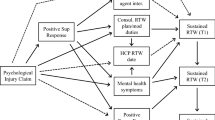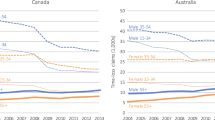Abstract
Objective To examine if the factors associated with days of absence following a work-related injury are similar for mental health versus musculoskeletal (MSK) conditions. Methods A secondary analysis of wage replacement workers’ compensation claims in the state of Victoria, Australia. We examined the relationship between individual, injury, occupational and workplace variables with days of wage replacement over the 2-year period following first day of absence from work separately for mental health claims and MSK claims using negative binomial regression models. Results Mental health conditions were associated with a greater number of days of absence over the 2 years following first incapacity compared to MSK conditions. Differences were observed in employment, injury and industry variables on absence from work for mental claims compared to MSK claims. Working in the agriculture, forestry, fishing and mining industries and employment with a small organisation were more strongly associated with the number of days of wage-replacement among MSK compared to mental health claims, and working in the public administration and safety, or education and training industries or being employed in a position with high time pressure were associated with greater days of wage-replacement among mental health compared to MSK claims. Conclusions Predictors of days away from work in the 2 years following an injury differ for mental health versus MSK claims. Given the increasing number of mental health claims in Australia more research is required to understand differences in return-to-work for this group of claimants compared to those with physical injuries.
Similar content being viewed by others
References
Franche RL, Baril R, Shaw W, Nicholas M, Loisel P. Workplace-based return-to-work interventions: optimizing the role of stakeholders in implementation and research. J Occup Rehabil. 2005;15(4):525–42.
Loisel P, Buchbinder R, Hazard R, Keller R, Scheel I, van Tulder M, et al. Prevention of work disability due to musculoskeletal disorders: the challenge of implementing evidence. J Occup Rehabil. 2005;15(4):507–24.
Shaw WS, Linton SJ, Pransky G. Reducing sickness absence from work due to low back pain: how well do intervention strategies match modifiable risk factors? J Occup Rehabil. 2006;16(4):591–605.
Schultz IZ, Stowell AW, Feuerstein M, Gatchel RJ. Models of return to work for musculoskeletal disorders. J Occup Rehabil. 2007;17:327–52.
Steenstra IA, Verbeek JH, Heymans MW, Bongers PM. Prognostic factors for duration of sick leave in patients sick listed with acute low back pain: a systematic review of the literature. Occup Environ Med. 2005;62(12):851–60.
Laisne F, Lecomte C, Corbiere M. Biopsychosocial predictors of prognosis in musculoskeletal disorders: a systematic review of the literature. Disabil Rehabil. 2012;34(5):355–82.
Iles RA, Davidson M, Taylor NF. Psychosocial predictors of failure to return to work in non-chronic non-specific low back pain: a systematic review. Occup Environ Med. 2008;65(8):507–17.
Comcare. Comcare submission to the public hearing on mental health: House standing committee on education and employment inquiry into mental health and workplace participation. Canberra: Comcare, Federal Government 2011.
WorkSafe Victoria. Statistical summary. WorkSafe Victoria, Melbourne, Victoria. 2010. http://www.worksafe.vic.gov.au/forms-and-publications/forms-and-publications/statistical-summary. Accessed 28 Aug 2012.
Lippel K. Law, public policy and mental health in the workplace. Healthcare Papers. 2010.
Government of British Columbia. Bill 14—Mental disorder legislation. In: WorkSafeBC, editor. Vancouver, BC 2011.
Cornelius LR, van der Klink JJ, Groothoff JW, Brouwer S. Prognostic factors of long terms disability due to mental disorders: a systematic review. J Occup Rehabil. 2011;21:259–74.
Brouwer S, Reneman MF, Bultmann U, van der Klink JJ, Groothoff JW. A prospective study of return to work across health conditions: perceived work attitude, self-efficacy and perceived social support. J Occup Rehabil. 2010;20:104–12.
Wahlin C, Ekberg K, Persson J, Bernfort L, Oberg B. Association between clinical and work-related interventions and return-to-work for patients with musculoskeletal or mental disorders. J Rehabil Med. 2012;44(4):355–62.
Huijs JJJM, Koppes LLJ, Taris TW, Blonk RWB. Differences in predictors or return to work among long-term sick-listed employees with different self-reported reasons for sick leave. J Occup Rehabil. 2012;22(3):301–11.
Andersen MF, Nielsen KM, Brinkmann S. Meta-synthesis of qualitative research on return to work among employees with common mental disorders. Scand J Work Environ Health. 2012;38(2):93–104. doi:10.6271/sjweh.3257.
Zwerling C, Whitten PS, Sprince NL, Davis CS, Wallace RB, Blanck P, et al. Workplace accommodations for people with disabilities: National Health Interview Survey Disability Supplement, 1994–1995. J Occup Environ Med. 2003;45(5):517–25.
Krause N, Dasinger LK, Deegan LJ, Rudolph L, Brand RJ. Psychosocial job factors and return-to-work after compensated low back injury: a disability phase specific analysis. Am J Ind Med. 2001;40:374–92.
Nielsen MBD, Bultmann U, Madsen IEH, Martin M, Christensen U, Diderichsen F, et al. Health, work, and personal-related predictors of time to return to work among employees with mental health problems. Disabil Rehabil. 2012;34(15):1311–6.
Koopmans PC, Roelen CAM, Groothoff JW. Sickness absence due to depressive symptoms. Int Arch Occup Environ Health. 2008;81:711–9.
Eakin JM, Champoux D, MacEachen E. Health and safety in small workplaces: refocusing upstream. Can J Public Health. 2010;101:S29–33.
Schultz IZ, Duplassie D, Hanson DB, Winter A. Systemic barriers and facilitators to job accommodations in mental health: experts’ consensus. In: Schultz IZ, Rogers ES, editors. Work accommodation and retention in mental health. New York: Springer; 2011.
Smith PM, Stock SR, McLeod CB, Koehoorn M, Marchand A, Mustard CA. Research opportunities using administrative databases and existing surveys for new knowledge in occupational health and safety in Canada, Quebec, Ontario and British Columbia. Can J Public Health. 2010;101:S46–52.
Victoria WorkSafe. VCODE: the nature of injury/disease classification system for Victoria. Melbourne: WorkSafe Victoria; 2008.
Australian Bureau of Statistics. ANZSCO—Australian and New Zealand standard classification of occupations. Canberra, Australia 2005. Report No.: ABS Catalogue No. 1221.0.
Human Resources & Skills Development Canada. National occupational classification career handbook. Ottawa, ON: Government of Canada; 2011.
National Center for O*NET Development. O*Net OnLine. 2012. http://www.onetonline.org/. Accessed 11 Nov 2012.
Allison PD. Comparing logit and probit coefficients across groups. Sociol Methods Res. 1999;28(2):186–208.
Austin PC, Hux JE. A brief note on overlapping confidence intervals. J Vasc Surg. 2002;36(1):194–5.
Franche RL, Cullen K, Clarke J, Irvin E, Sinclair S, Frank J. Workplace-based return-to-work interventions: a systematic review of the quantitative literature. J Occup Rehabil. 2005;15(4):607–31.
Collie A, Pan Y, Britt H, Henderson J. Coverage of work-related problems by workers’ compensation in general practice. Int J Social Secur Work Compens. 2011;3(1):1–11.
Heymans MW, Anema JR, van Buuren S, Knol DL, van Mechelen W, De Vet HCW. Return to work in a cohort of low back pain patients: development and validation of a clinical prediction rule. J Occup Rehabil. 2009;19(2):155–65.
Stover B, Wickizer TM, Zimmerman F, Fulton-Kehoe D, Franklin G. Prognostic factors of long-term disability in a workers’ compensation system. J Occup Environ Med. 2007;49(1):31–40.
Kucera KL, Lipscomb HJ, Silverstein B, Cameron W. Predictors of delayed return to work after back injury: a case-control analysis of union carpenters in Washington State. Am J Ind Med. 2009;52:821–30.
Smith PM, Bielecky A. The impact of changes in job strain and its components on the risk of depression. Am J Public Health. 2012;102(2):352–8. doi:10.2105/AJPH.2011.300376.
Thielen K, Nygaard E, Rugulies R, Diderichsen F. Job stress and the use of antidepressant medicine: a 3.5-year follow-up study among Danish employees. Occup Environ Med. 2010;68(3):205–10.
Acknowledgments
Peter Smith is supported by a Discovery Early Career Researcher Award from the Australian Research Council. Tessa Keegel is supported by a National Health and Medical Research Council Early Career Fellowship.
Author information
Authors and Affiliations
Corresponding author
Rights and permissions
About this article
Cite this article
Smith, P.M., Black, O., Keegel, T. et al. Are the Predictors of Work Absence Following a Work-Related Injury Similar for Musculoskeletal and Mental Health Claims?. J Occup Rehabil 24, 79–88 (2014). https://doi.org/10.1007/s10926-013-9455-8
Published:
Issue Date:
DOI: https://doi.org/10.1007/s10926-013-9455-8




